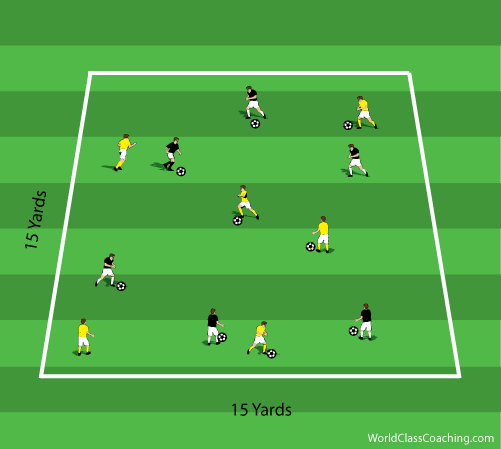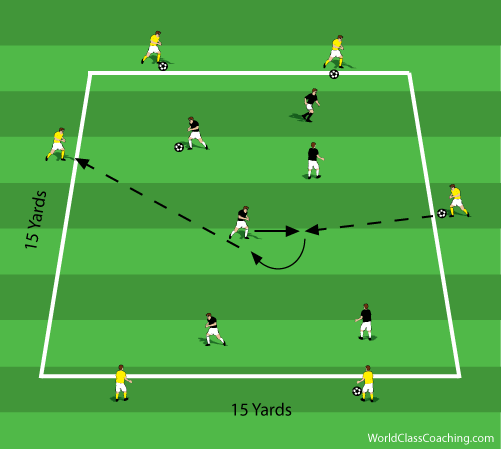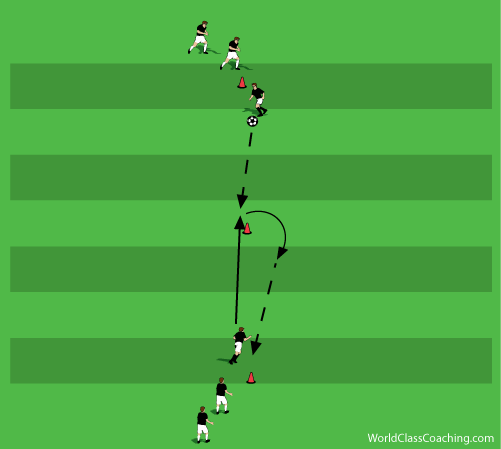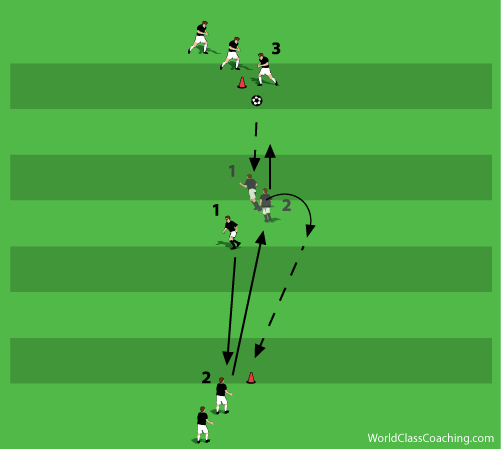Teaching players to turn with the ball is an area that I don't see covered very often by coaches working with players from eight to 12. I'm not sure if it is because the coaches think the topic is difficult to teach young players or because they don't want to take time away from areas they consider more important.
I teach it because I think there are a lot of different skills that can be worked on in one set of exercises. Passing, first touch, awareness of space and pressure, balance and coordination. With the youngest players I keep it very simple and focus on three types of turns: inside of the foot, outside of the foot and Cruyff turns. The pressure is limited to cones. With older or more advanced players the pressure is increased and I become more picky about every aspect from the pass to the side the players turn to.
This is the progression that I like to use:
Dribble Inside a 15x15-yard Grid
Each player has a ball and dribbles freely at first. Then with their favorite foot only using the inside and outside of the foot. Next, using only the other foot. After that I demonstrate and inside of the foot turn (or chop), then an outside of the foot turn (or hook) and finally a Cruyff turn where the ball goes between their legs.
This is all done to prepare for the turns that will be used when they receive the ball from a pass.
Players Inside and Out
Half of the players are on the inside of the 15x15-yard grid without a ball and the other half are on the outside with a ball at their feet.
The players on the inside check toward a player with the ball, ask for it, take a touch to control the ball and then turn with one of the three techniques worked on in the warm-up. Next, they dribble away and pass to one of the outside players who doesn't have a ball. Once each group has a couple of chances to try this, the players use only one touch to turn.
Turn Around a Cone
Four two six players are the perfect number of each group in this exercise. The player in the front of one line has a ball. The front player in the other line checks in front of a cone in the center that represents a defender. The pass is made when the checking player asks for the ball. He then turns around the cone to one side or the other, passes the ball to the next person in the line he came from and runs to the end of the line. The first passer then runs in front of the defender and the pattern continues.
There is so much to coach here and it is only limited by the experience level of the players. You can keep it as simple or complex as you like.
Progression
Now the cone is removed and one player starts in the middle. The middle player checks away from the ball and tag the first player in the other line and comes back to show for the ball. The player who was tagged follows the other player toward the ball and acts as a passive defender. The receiving player turns around the defender and passes to the next player in line. The defender continues their run and tags the passer before showing to the middle and asking for the ball. The passer now acts as a defender and the pattern continues.
I start by having the players walk through this until they start to understand the pattern. Then I can start to coach their technique and decision making. I've done this with players as young as eight and they start to have fun with the constant movement and activity the more they do it.
Once I give the defender a chance to touch the ball the players start to see how the exercise relates directly to situations they face in the game.
We end with small-sided games where I point out opportunities to turn or praise players who use the techniques we worked on.






